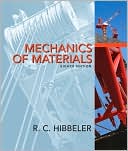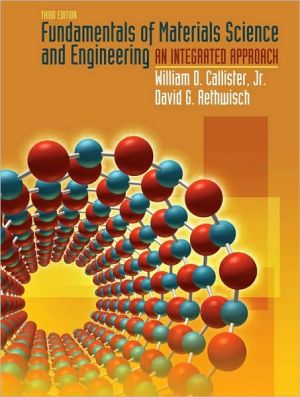Introduction to Materials Science for Engineers
This book provides balanced, current treatment of the full spectrum of engineering materials, covering all the physical properties, applications and relevant properties associated with engineering materials. The book explores all of major categories of materials while offering detailed examinations of a wide range of new materials with high-tech applications. The reader is treated to state-of-the-art computer generated crystal structure illustrations, offering the most technically precise and...
Search in google:
This book provides balanced, current treatment of the full spectrum of engineering materials, covering all the physical properties, applications and relevant properties associated with engineering materials. The book explores all of major categories of materials while offering detailed examinations of a wide range of new materials with high-tech applications. The reader is treated to state-of-the-art computer generated crystal structure illustrations, offering the most technically precise and visually realistic illustrations available. The book includes over 350 exercises with sample problems to provide guidance. Materials for Engineering, Atomic Bonding, Crystal Structure and Defects, Diffusion, Mechanical Behavior, Thermal Behavior, Failure Analysis & Prevention. Phase Diagrams, Heat Treatment, Metals, Ceramics and Glasses, Polymers, Composites, Electrical Behavior, Optical Behavior, Semiconductor Materials, Magnetic Materials, Environmental Degradation, Materials Science. For mechanical and civil engineers and machine designers. Booknews Designed for an introductory course in engineering materials, this text begins with the basics of materials science, chemistry, and physics that are required for understanding engineering materials. Subsequent chapters cover structural (metals, ceramics, polymers, and composites) and electronic, optical, and magnetic materials. The final section examines the ways engineers use materials in design, analyzing environmental degradation and materials selection. Annotation c. Book News, Inc., Portland, OR (booknews.com)
1 Materials for Engineering 11.1 The Material World 11.2 Materials Science and Engineering 21.3 Six Materials That Changed Your World 3STEEL BRIDGES–INTRODUCING METALS 3LUCALOX LAMPS–INTRODUCING CERAMICS 5OPTICAL FIBERS–INTRODUCING GLASSES 9NYLON PARACHUTES–INTRODUCING POLYMERS 11KEVLAR®-REINFORCED TIRES–INTRODUCINGCOMPOSITES 13SILICON CHIPS–INTRODUCING SEMICONDUCTORS 141.4 Processing and Selecting Materials 151.5 Looking at Materials by Powers of Ten 17PART I The Fundamentals2 Atomic Bonding 222.1 Atomic Structure 222.2 The Ionic Bond 28COORDINATION NUMBER 322.3 The Covalent Bond 392.4 The Metallic Bond 452.5 The Secondary, or van der Waals, Bond 472.6 Materials–The Bonding Classification 503 Crystalline Structure–Perfection 583.1 Seven Systems and Fourteen Lattices 583.2 Metal Structures 623.3 Ceramic Structures 663.4 Polymeric Structures 743.5 Semiconductor Structures 763.6 Lattice Positions, Directions, and Planes 803.7 X-Ray Diffraction 924 Crystal Defects and NoncrystallineStructure–Imperfection 1024.1 The Solid Solution–Chemical Imperfection 1024.2 Point Defects–Zero-DimensionalImperfections 1084.3 Linear Defects, or Dislocations–One-DimensionalImperfections 1104.4 Planar Defects–Two-DimensionalImperfections 1134.5 Noncrystalline Solids–Three-DimensionalImperfections 1185 Diffusion 1265.1 Thermally Activated Processes 1265.2 Thermal Production of Point Defects 1305.3 Point Defects and Solid-State Diffusion 1325.4 Steady-State Diffusion 1425.5 Alternate Diffusion Paths 1466 Mechanical Behavior 1526.1 Stress Versus Strain 152METALS 153CERAMICS AND GLASSES 164POLYMERS 1686.2 Elastic Deformation 1736.3 Plastic Deformation 1746.4 Hardness 1816.5 Creep and Stress Relaxation 1856.6 Viscoelastic Deformation 193INORGANIC GLASSES 194ORGANIC POLYMERS 196ELASTOMERS 1997 Thermal Behavior 2107.1 Heat Capacity 2107.2 Thermal Expansion 2137.3 Thermal Conductivity 2167.4 Thermal Shock 2218 Failure Analysis and Prevention 2278.1 Impact Energy 2288.2 Fracture Toughness 2338.3 Fatigue 2378.4 Nondestructive Testing 2468.5 Failure Analysis and Prevention 2499 Phase Diagrams–EquilibriumMicrostructural Development 2579.1 The Phase Rule 2589.2 The Phase Diagram 261COMPLETE SOLID SOLUTION 262EUTECTIC DIAGRAM WITH NO SOLID SOLUTION 265EUTECTIC DIAGRAM WITH LIMITED SOLID SOLUTION 267EUTECTOID DIAGRAM 269PERITECTIC DIAGRAM 271GENERAL BINARY DIAGRAMS 2759.3 The Lever Rule 2819.4 Microstructural Development During SlowCooling 28510 Kinetics–Heat Treatment 30410.1 Time–The Third Dimension 30410.2 The T T T Diagram 309DIFFUSIONAL TRANSFORMATIONS 310DIFFUSIONLESS (MARTENSITIC) TRANSFORMATIONS 311HEAT TREATMENT OF STEEL 31610.3 Hardenability 32410.4 Precipitation Hardening 32710.5 Annealing 330COLD WORK 331RECOVERY 331RECRYSTALLIZATION 332GRAIN GROWTH 33410.6 The Kinetics of Phase Transformations forNonmetals 335PART II Materials and TheirApplications11 Structural Materials–Metals,Ceramics, and Glasses 34811.1 Metals 348FERROUS ALLOYS 348NONFERROUS ALLOYS 35511.2 Ceramics and Glasses 359CERAMICS–CRYSTALLINE MATERIALS 360GLASSES–NONCRYSTALLINE MATERIALS 361GLASS-CERAMICS 36311.3 Processing the Structural Materials 365PROCESSING OF METALS 366PROCESSING OF CERAMICS AND GLASSES 37212 Structural Materials–Polymersand Composites 38112.1 Polymers 381POLYMERIZATION 382STRUCTURAL FEATURES OF POLYMERS 387THERMOPLASTIC POLYMERS 391THERMOSETTING POLYMERS 392ADDITIVES 39412.2 Composites 396FIBER-REINFORCED COMPOSITES 396AGGREGATE COMPOSITES 403PROPERTY AVERAGING 405MECHANICAL PROPERTIES OF COMPOSITES 41112.3 Processing the Structural Materials 416PROCESSING OF POLYMERS 416PROCESSING OF COMPOSITES 41713 Electronic Materials 42613.1 Charge Carriers and Conduction 42713.2 Energy Levels and Energy Bands 43113.3 Conductors 437THERMOCOUPLES 440SUPERCONDUCTORS 44113.4 Insulators 44913.5 Semiconductors 451INTRINSIC, ELEMENTAL SEMICONDUCTORS 452EXTRINSIC, ELEMENTAL SEMICONDUCTORS 457COMPOUND SEMICONDUCTORS 469PROCESSING OF SEMICONDUCTORS 472SEMICONDUCTOR DEVICES 47613.6 Composites 48513.7 Electrical Classification of Materials 48514 Materials in Engineering Design 49314.1 Material Properties–Engineering DesignParameters 49314.2 Selection of Structural Materials–CaseStudies 498MATERIALS FOR WINDSURFER MASTS 499METAL SUBSTITUTION WITH COMPOSITES 503MATERIALS FOR HIP-JOINT REPLACEMENT 50314.3 Selection of Electronic Materials–CaseStudies 506AMORPHOUS METAL FOR ELECTRIC-POWERDISTRIBUTION 507LIGHT-EMITTING DIODE 51114.4 Materials and Our Environment 514ENVIRONMENTAL DEGRADATION OF MATERIALS 514ENVIRONMENTAL ASPECTS OF DESIGN 523RECYCLING 526APPENDIX ONEPhysical and Chemical Datafor the Elements A-1APPENDIX TWOAtomic and Ionic Radii of the Elements A-4APPENDIX THREEConstants and Conversion Factors A-7APPENDIX FOURProperties of the Structural Materials A-8APPENDIX FIVEProperties of the Electronic Materials A-17APPENDIX SIXGlossary A-20Answers to Practice Problems (PP)and Odd-Numbered Problems AN-1Index I-1
\ BooknewsDesigned for an introductory course in engineering materials, this text begins with the basics of materials science, chemistry, and physics that are required for understanding engineering materials. Subsequent chapters cover structural (metals, ceramics, polymers, and composites) and electronic, optical, and magnetic materials. The final section examines the ways engineers use materials in design, analyzing environmental degradation and materials selection. Annotation c. Book News, Inc., Portland, OR (booknews.com)\ \








